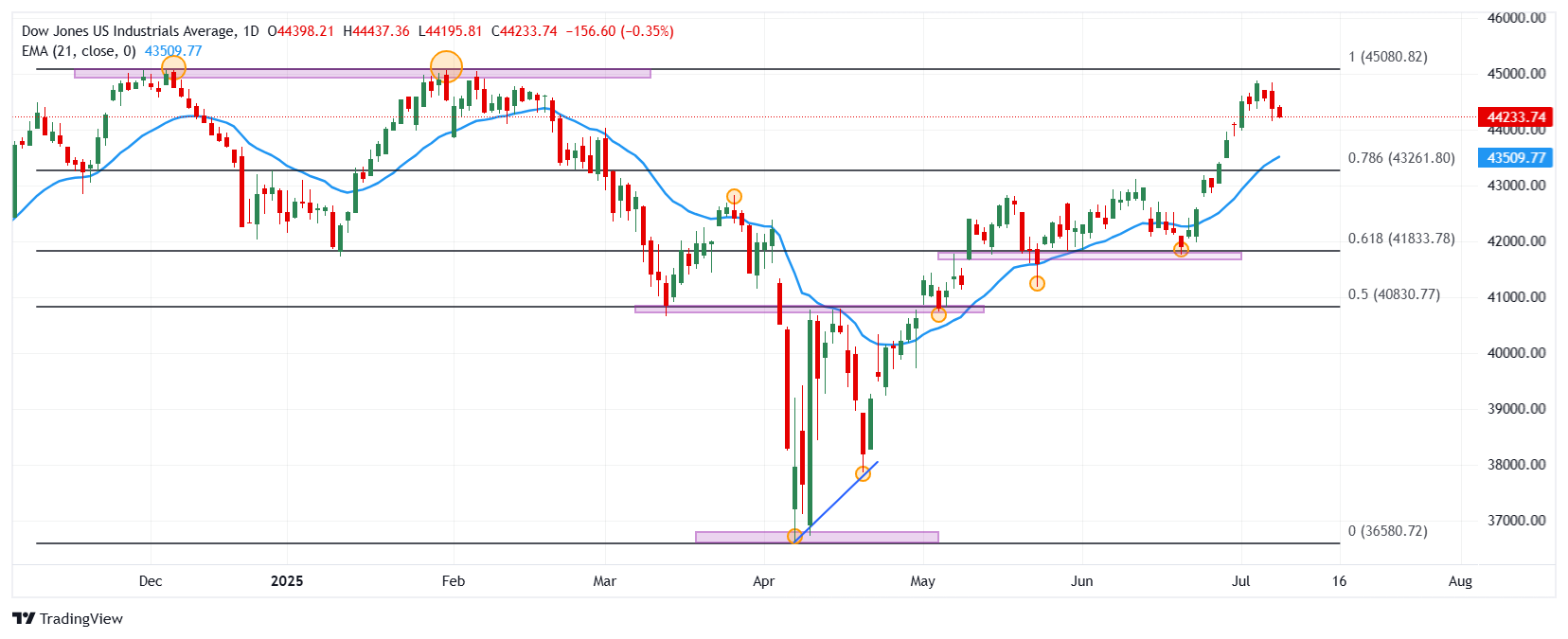- Dow Jones falls 0.35% today, staying within the operational range of the previous session at 44,233.
- The Nasdaq 100 advances 0.03% daily, operating when writing about 22,693.
- The S&P 500 goes back 0.11% on the second day of the week, dragged by Fair Isaac Corporation (FICO).
- The attention of investors will be in the publication of the Minutes of the Federal Reserve, tomorrow.
- The president of the United States, Donald Trump, announces the imposition of a 10% tariff to the countries of the BRICS Group.
The Dow Jones established a daily maximum in 44,398, finding vendors that took the index to a minimum of the day in 44,195.
The Dow Jones industrial average began negotiations at 44,398, while the Nasdaq 100 technological index began operating at 22,724. The S&P 500 opened in 6,235, consolidating the short -term bassist perspective.
The Dow Jones ends in negative terrain dragged by Nike and JP Morgan
The Dow Jones index presents a daily loss of 0.35%, registering a minimum of the day at 44,195
Nike titles go back 3.41% in the day, visiting minimums of three days the $ 73.65, leading the losses in the index and finishing a streak of four consecutive days upwards.
Following the bassist perspective, the actions of JPMorgan (JPM) fall 3.15% today, visiting minimums of June 24 in 280.31 $, signing its second consecutive day with losses.
The Dow Jones slides 156 points, spinning three consecutive sessions in negative terrain, currently quoting in 44,233.
The Nasdaq 100 el Nasdaq 100 is maintained in the profit zone supported by Intel Corporation and Globalfoundries
The Nasdaq 100 technological index advances 0.03% today, staying within the range of the July 7 session at 22,693.
Intel Corporation (INTC) values shoot 7.23% daily, reaching maximums not seen since April 3 at $ 23.79, leading profits in Nasdaq 100.
In the same tonic the globalfoundries titles (GFS) rebound 6.96% on Tuesday, reaching maximum of February 25 in $ 41.85.
In this sense, the Nasdaq 100 rises 6 points, consolidating within the range of the previous session at 22,693.
The S&P 500 ends the day with losses dragged by Fair Isaac Corporation and First Solar
The president of the United States, Donald Trump, continues to increase commercial tensions by establishing a 50% tariff over all copper imports to the United States. In addition, he announced additional 25% tariffs, especially imports from South Korea and Japan. effective as of August 1.
The Fair Isaac Corporation (FICO) titles record a loss of 8.91% on the second day of the week, visiting minimal not seen since May 27 in $ 1,520, ending with a streak of two consecutive days.
On the other hand, the shares of First Solar (FSLR) slide 6.54% daily, reaching minimum of July 2 in $ 165.15, spinning two consecutive sessions with losses.
The attention of the operators will be in the minutes of the Federal Reserve, in search of indications that define the rhythm of type cuts in the short term.
The S&P 500 falls 6 points in the day, currently quoting in 6,223.
Technical Analysis of Dow Jones
The Dow Jones formed a short -term support given by the minimum of June 19 in 41,971. The following key support is observed in 40,747, a pivot point of May 6, in convergence with the 50% fibonacci setback. Upwards, the important resistance is 45,068, maximum of January 31.
Dow Jones daily graphics

Dow Jones – Frequently Questions
The Dow Jones Industrial Avenge, one of the oldest stock market indexes in the world, consists of the 30 most negotiated values in the United States. The index is weighted by the price instead of capitalization. It is calculated by adding the prices of the values that compose it and dividing them by a factor, currently 0.152. The index was founded by Charles Dow, also founder of the Wall Street Journal. In recent years it has been criticized for not being sufficiently representative, since it only follows 30 companies, unlike broader rates such as S&P 500.
There are many factors that promote the Dow Jones Industrial Average (DJIA) index. The main one is the added performance of the companies that compose it, revealed in the quarterly reports of business benefits. The American and world macroeconomic data also contribute, since they influence investor confidence. The level of interest rates, set by the Federal Reserve (FED), also influences the DJia, since it affects the cost of credit, on which many companies depend largely. Therefore, inflation can be a determining factor, as well as other parameters that influence the decisions of the Federal Reserve.
Dow’s theory is a method to identify the main trend of the stock market developed by Charles Dow. A key step is to compare the direction of the Dow Jones Industrial Avenge (DJIA) and the Dow Jones Transportation Average (DJTA) and just follow the trends in which both move in the same direction. The volume is a confirmation criterion. The theory uses elements of maximum and minimum analysis. Dow’s theory raises three phases of the trend: accumulation, when intelligent money begins to buy or sell; Public participation, when the general public joins the trend; and distribution, when intelligent money abandons the trend.
There are several ways to operate with the DJ. One of them is to use ETF that allow investors to negotiate the DJ as a single value, instead of having to buy shares of the 30 companies that compose it. An outstanding example is the SPDR Dow Jones Industrial Avenge ETF (day). Future contracts on the DJ allow the specular operators about the future value of the index and the options provide the right, but not the obligation, to buy or sell the index at a predetermined price in the future. Investment funds allow investors to buy a part of a diversified portfolio of DJ values, which provides exposure to global index.
Source: Fx Street
I am Joshua Winder, a senior-level journalist and editor at World Stock Market. I specialize in covering news related to the stock market and economic trends. With more than 8 years of experience in this field, I have become an expert in financial reporting.







